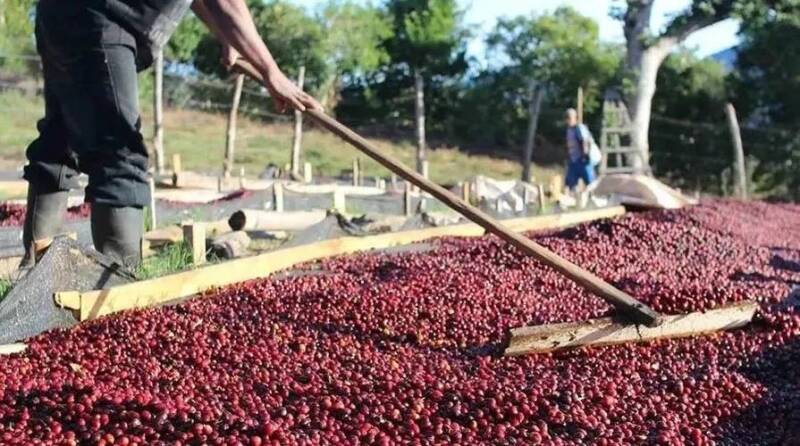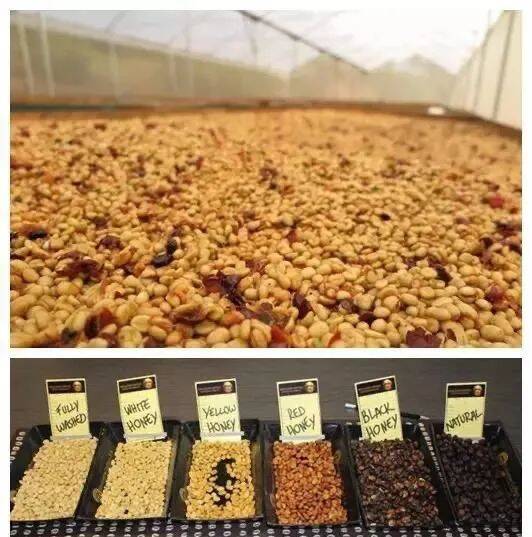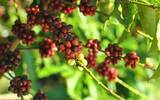History of honey treatment in Costa Rica, honey treatment process, introduction of strawberry sugar in Mirasu Estate
At present, with the continuous development of the coffee industry, the current coffee treatment methods emerge in endlessly. The relatively new treatment methods include anaerobic method, double anaerobic solarization method, enzyme washing method, wine barrel fermentation and so on. But the most common are three common traditional treatments.

The three traditional coffee treatments are traditional sun treatment (Natural Sun-dried Method), traditional water washing (Traditional Fully Washed), Hybrid Process between sun and water washing (Hybrid Process), including semi-washing (Semi Washed), honey treatment (Honey Process) and so on. But nowadays, the treatment methods have become more and more diverse, and some international buyers and raw bean chambers of commerce have more diverse requirements for quality, flavor and uniqueness. The fruits picked from the same coffee tree will have different flavors when they are made by different treatments, even if only minor steps or fine-tuning of fermentation time can lead to different flavors. Just like honey treatment, honey treatment is an intermediate treatment between sun exposure and water washing. According to the degree of honey treatment, honey treatment is divided into yellow honey treatment, red honey treatment, black honey treatment and white honey treatment, and the latest is raisin honey treatment.

Wash white honey, yellow honey, red honey, black honey in the sun
When it comes to honey treatment, Costa Rica has to be mentioned. Costa Rica is the birthplace of honey treatment. It can be said that the geographical environment of Costa Rica has created the method of honey treatment. Costa Rican coffee growing area beans are concentrated in the Taramanca Mountains, where 1200-1650 meters above sea level, although the precipitation is rich, but in the alpine areas, it is difficult to store water and it is difficult to support water-intensive washing treatment. But it is not like African countries to have a long time of light, and the sun treatment also has a greater risk. So go to learn from the Brazilian half-sun, half-sun is to peel off the pericarp, rinse with water for 1 hour, and then spread out for sun drying. A large number of Central American coffee-producing countries, such as Costa Rica, El Salvador and Guatemala, saw that the treatment did not consume water and could shorten the duration of light, so they began to follow suit and improve it according to their own conditions, so these Central Americans called it honey treatment.
The improved honey treatment method is to peel off the peel and part of the pectin of coffee berries, so a peel removal machine is used to ensure high precision. Precise control of the thin thickness of pectin, then dripping non-stick directly on the high drying rack to dry. The subdivided black honey, red honey, yellow honey and white honey are different colors corresponding to the degree of pectin retention.
Retain 80% pectin, sun for 12 days, dried coffee beans with shells will appear reddish brown, so it is called red honey. The pectin layer remains 40-60% and is insolated for about 8 days. Because the pectin becomes thinner, the dried coffee beans with shells will be yellowish brown, so they are called yellow honey. White honey retains 40% of the pectin layer, and the drying time is short, so the color of shelled coffee is lighter. Black honey hardly removes pectin and lasts for more than 14 days, so shelled coffee beans tend to be black.
Now the updated honey treatment is raisin honey treatment, and strawberry candy from Milasu Manor in Costa Rica is treated with raisin honey on the front street. 100% pectin and zero water treatment are retained on raisin honey treatment, which increases the difficulty of honey treatment and requires strict control of time. After harvesting the coffee cherries, pour them into a large trough and screen the underdeveloped floating beans by buoyancy. After drying on the viaduct bed, remove the cherry peel, keep the pectin and dry, the drying process needs to be turned constantly to ensure uniform drying, slow drying to ensure that the coffee is fermented, and pay attention to the weather conditions during the period. Make sure that the moisture content of coffee beans is reduced to about 11%.
The strawberry candy of this Mirazhu manor is produced in Tarazhu. it is a mixture of 50% rose summer coffee beans and Ethiopian native species ET47 as well as SL28 and MAICO. It is boiled and tasted in the proportion of V60, 1 and 15, with strawberry and raisin flavor in the mouth, candy and nut flavor in the finish, and a creamy, honey-like taste.
Important Notice :
前街咖啡 FrontStreet Coffee has moved to new addredd:
FrontStreet Coffee Address: 315,Donghua East Road,GuangZhou
Tel:020 38364473
- Prev

Coffee supply in Vietnam began to increase, and coffee prices began to fall.
Earlier, the Vietnamese Coffee and Cocoa Association (Vicofa) said that the price of Vietnamese coffee is expected to continue to rise in 2024 because of coffee supply shortages. The coffee production season in Vietnam is from November to March of the following year, but when the new production season began in November this year, the price of coffee had reached 60000 dong / kg.
- Next

There is a heated discussion about choosing food in Starbucks.
▲ click follow | Daily boutique coffee culture magazine Coffee Workshop is well known, as a chain coffee shop, Starbucks brand positioning and service content are very clear. It is committed to providing coffee, drinks, meals, as well as "matching" a comfortable third space for consumers. For a long time, a lot of consumption
Related
- What effect does Italian American coffee with filter paper have? Will coffee taste better if it is put on filter paper at the bottom of the powder bowl?
- What is the color difference in coffee beans? What are the characteristics of honey processed coffee beans? Why are the anaerobically treated coffee beans uneven in color?
- How does novice Xiaobai quickly get started and make coffee? Newbies learn to make coffee by hand and share the specific steps and process process!
- Costa tea has a shelf life of 100 years?! Expert: Unable to verify
- It's a huge uproar! American milk addition was rejected by Manner employees?!
- Mocha pot coffee bean recommendations| How fine and how much powder should be used for grinding? What parameter ratios do I need to use to make milk with Mocha pot coffee?
- What are the characteristics of the world's top ten coffee beans treated with Costa Rica honey? How to make black honey kadura from Tarazhu Pilon Processing Plant taste good?
- How to make deep-roasted coffee? What grinding water temperature does authentic Jamaica Blue Mountain No. 1 coffee use to brew it well?
- Selected high-grade rose summer coffee flavor tasting guide Why Panama rose summer has the aroma of flowers and fruits
- What equipment does a novice Xiaobai need to buy to learn to make coffee? Filter cup electronic scale bean grinder manual flushing pot purchase guide

